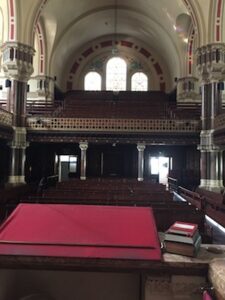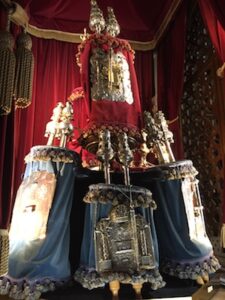Inside the First Reform Synagogue in the UK
Meredith Bergman ’19 and Maggie Goldberger ’19

Reform Judaism is currently the largest denomination of Jews in the world. As Jews ourselves, we were curious about the Jewish Reform Movement that took place during the nineteenth century, as well as its lasting implications. We decided to focus our project on the historic West London Synagogue, located near Marble Arch.

The Jewish Reform Movement emerged out of the tail end of the Haskalah, or Jewish enlightenment, which was in its peak from 1770 to 1881. An Eastern and Central European movement, the Haskalah shared many of the social and political aims of the “mainstream” Enlightenment period, and shared its emphasis on rationalism and increased secularism, but had a specifically Jewish focus. The movement calling for increased integration with the non-Jewish world in promoting adoption of the vernacular language (most Jewish communities at the time spoke various Jewish dialects like Yiddish), a movement away from a solely religious focus in schooling, and from traditional and ritual practices that seemed to serve little purpose in the modern world, and which effectively served to further culturally isolate Jews from non-Jews (Biale). These ideas and reforms laid the groundwork for the gradual beginnings of the Reform Movement, founded in the early nineteenth century by Israel Jacobson and Leopold Zunz, German reformers who believed that Jewish practice should move towards emphasizing moral teachings over strictly legalist and ritually based Orthodox practice. As the movement gained steam, it went on to assert a belief that the Tanakh (or “Hebrew Bible”) was written by men rather than stemming from direct divine inspiration, and thus the more than 613 biblical commandments to the Jewish people were not seen as binding (Cohn-Sherbok). This movement both religiously and politically motivated, and many of the later reforms in worship services (the addition of pews, an organ, and a choir in the synagogue) made Jewish worship more recognizable to Christians, which many reformers hoped would pave the way for political emancipation and wider acceptance of the Jewish population.
While Central Europe and the United States saw a massive Reform Movement, the Reform Movement in Britain was much less significant in the mid-nineteenth century. The West London Synagogue remained the only Reform Synagogue in Britain for several decades, with a small congregation. While the Central European Jews who felt that “the Orthodox prayer book included

prayers which appeared inconsistent with the claim that the Jews differed from their fellow-countrymen in religion only and not in their national identity” began practicing this very “Christianized” version of Judaism, members of the Western London Synagogue practiced more traditional version of Judaism (Sharot 223). Reformers in Britain maintained social ties with the Orthodox community more than those in Central Europe during the mid-nineteenth century. In Central Europe, political emancipation (which would be gained by abandoning traditional Orthodox practices) was considered “a prelude to the social acceptance of Jews by gentiles” (214). However, in Britain, political emancipation was not considered a bridge between religious practices and social acceptance the same way that it was in Central Europe. Sir Moses Montefiore, an extremely prominent English Jew, wrote in 1837: “I am most firmly resolved not to give up the smallest part of our religious forms and privileges to obtain civil rights” (Sharot 214). The Mocatta and Goldsmid families had established themselves in Britain several generations before founding the West London Synagogue, and had accumulated enough wealth to be socially accepted by English aristocrats. Because these two families, and other wealthier members of the West London Synagogue had achieved social acceptance without gaining political emancipation, they felt more comfortable remaining relatively dedicated to their more traditional religious practices than did many Central European Jews (Sharot).
However, by the 1870s the demographics of Jewish London had begun to shift significantly, with a large influx of Jews from Russia and Eastern Europe immigrating to London. Tensions quickly rose between long-established and well assimilated Reform Jews and these newcomers, who were mostly Yiddish speaking, generally from poor rural backgrounds, and traditionally observant Orthodox Jews. Many British Jews feared that this large group, which represented many of the “foreign” characteristics of Judaism that they had tried to distance themselves from, would threaten their level of acceptance and social mobility within Britain. At the same time, the rapid growth and continued liberalization of the Reform movement, caused deep tension among observant Jews, who feared the destabilization of their faith and traditions by this group that had broken away from so much that Orthodox Jews viewed as central to their cultural and religious identity. To both groups, it seemed that Judaism could not survive in the vision of the other. In the midst of these growing tensions, the West London Synagogue relocated from its original Bloomsbury location, to its current Marble Arch location, following the movement of a large portion of the Jewish community to this neighborhood.

On September 16th 1870, The Jewish Chronicle, a newspaper that catered specifically to the needs of the London-based Jewish community, published a series of articles and announcements surrounding the grand re-opening of the synagogue just before the High Holidays. In a piece entitled “Reconciliation” (part of a larger series the paper had run that year entitled “The Synagogue Question,” focusing on the questions raised for Jews as progressive Jewish movements rose in prominence) the editors of the paper call for an end to the enormous discord that had divided the community along Reform-Orthodox lines, and stressing “…the feasability of a re-union which must come sooner or later, even if it be delayed, till we, brethren of Israel, mount the Hill of Zion, shoulder by shoulder, under one common banner” (6), painting the division as one harmful to the political strength of the Jewish community of a whole, and referencing the nascent Zionist movement. The fears they raise over this divide and its’ negative impact on the creation of a Zionist state rings eerily true today, where divisions between Orthodox and Progressive Jews remains as a major issue of contention in Israel. Other articles on the issue echo this sentiment, however, focus more on the practical need for a strong united front among Jewish people in the wake of the intense violence and discrimination they faced in Britain and all over Europe during the period (8). Following this piece were several letters to the editor from Jews on all sides of the issue, who, while for the most part sharing the editors’ desires for a unification between the two parties, also argue over the many insurmountable issues upon which party lines had been drawn.

One Orthodox Jew wrote the following about what he saw as the dangers of the West London Synagogue, and the Reform movement as a whole:
“The discipline of the West London Synagogue of British Jews is not, as above quoted, a mere differentia of ritual; it strikes at the very foundation of Jewish polity. It protests against the the authority recognized by the whole House of Israel. It, in fact, repudiates all authority except its own. It is eclectic as well in principle as in practice. In some particulars it outstrips Caraite sectarian=ism: and in others it accepts Rabbinism in unquestioning faith: and in both it is inconsistent. It is a self-adjusted system, adopted at the whim and fancy of men having…little or no knowledge of traditional Judaism…changes so constituted are at once false in principle and dangerous to the last degree…If any set of men are to be permitted to organize their own system, where will they stop? A rift in resevoir, however small the one and strong the other, must ultimately prove fatal…Can there be a more erroneous principle in religious discipline than unauthorised changes?…Who shall say to the proud waves of turbulent innovation, so far and no farther?” (8).

During the World War II and post-World War II period, membership in the West London Synagogue increased greatly when many Jews fled to Britain before and during the Holocaust. The Synagogue has welcomed many Holocaust survivors into its congregation and, as Micky explained, it has embraced the responsibility of teaching the horrors of the Holocaust to younger generations at the Synagogue in order to ensure that it is “never forgotten.” A large memorial at the Synagogue honors Hugo Gryn, a Holocaust survivor, who, for 32 years, served as Assistant and later Senior Rabbi at the West London Synagogue. He was born in Czechoslovakia and was deported with his family to Auschwitz in 1944. He was liberated from Gunshkirchen (a sub-camp of Mauthausen) and moved to the UK in 1946. He joined the West London Synagogue in the 1960s. The fact that so many of the West London Synagogue’s members arrived in Britain as refugees before, during, and after the Holocaust informed the general ethos and moral code of the Synagogue, which remains dedicated to aiding refugees of all faiths today. The Synagogue funds a refugee drop in center in the building where refugees are given food, clothes, and money. The building is also used as a weekly homeless shelter that welcomes people of all faiths (Nathanson).

Today, the West London Synagogue is characterized by a progressive outlook that informs the way its Reform practices differ noticeably from Orthodox ones. According to the Micky, “the Torah has 613 commandments and we follow almost none of them.” The West London Synagogue, unlike Orthodox Synagogues, relies heavily on music (including organ music) during services. The Synagogue reads through one Torah scroll every three years, reading portions once a week. Orthodox Synagogues, who read three times a week, read through one Torah scroll every year. Some of the Synagogue’s practices reflect the Reform congregation’s progressive social attitudes. In Orthodox Synagogues women sit upstairs and men sit downstairs. Female rabbi’s are not allowed and women are not allowed on the bima (the stage on which the rabbi stands in front of the congregation). Since 1923, though, in the West London Synagogue, women and men have sat together. Women are allowed on the bimah (in fact, Micky invited us onto the bimah when we visited the Synagogue). The Synagogue was one of the first to ordain female rabbis. Of the four current Rabbis at the West London Synagogue, two are women and two are men. The West London Synagogue also uses gender neutral prayer books. The Synagogue also ordains openly gayrabbis and recognizes and performs same-sex marriages, unlike Orthodox Synagogues. All of these adjustments signal the ways that the Reform movement continues to be at the forefront of progressive Jewish movements (Nathanson).

Works Cited
Biale, David. Eros and the Jews, (London: University of California Press, 1997)
Cohn-Sherbrook, Dan. Judaism: History, Belief and Practice, (New York: Routledge, 2003)
Nathanson, Mickey. Personal Interivew. 24 May, 2017
Nero. “The Road to Reconciliation,” The Jewish Chronicle 77 (1870): 8
“Reconciliation,” The Jewish Chronicle 77 (1870): 6
Sharot, Stephen. “Reform and Liberal Judaism in London: 1840-1940.” Jewish Social Studies, vol. 41, no. 3/4, 1979, pp. 211–228. JSTOR,<www.jstor.org/stable/4467052>
Sherwood, Harriet. “Reports of antisemitic incidents increase to record levels in UK.” The Guardian.
